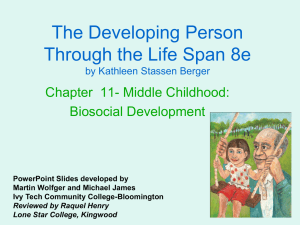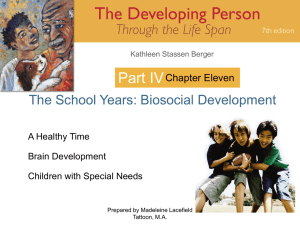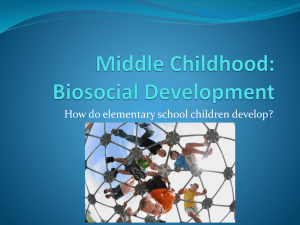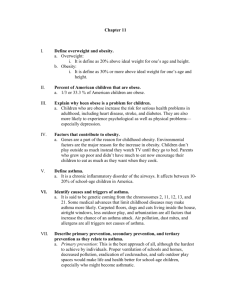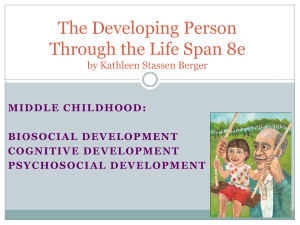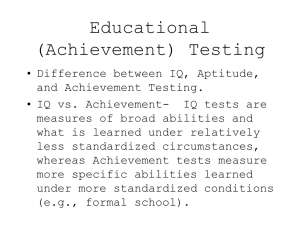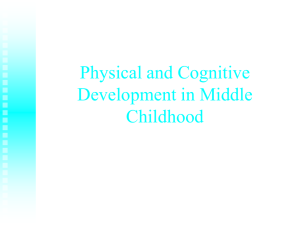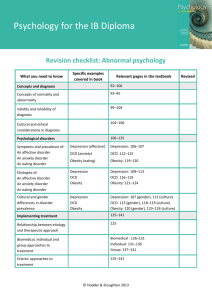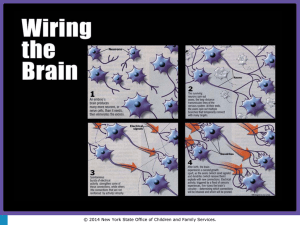Invitation to the Life Span by Kathleen Stassen Berger
advertisement
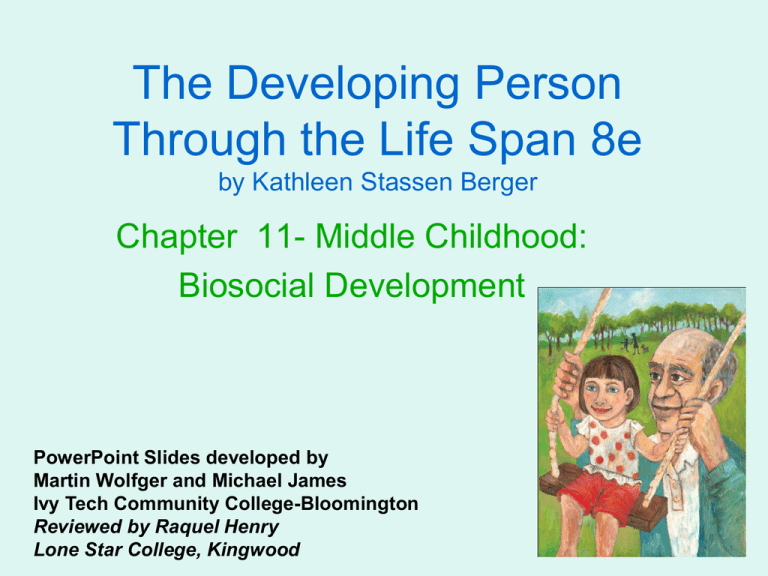
The Developing Person Through the Life Span 8e by Kathleen Stassen Berger Chapter 11- Middle Childhood: Biosocial Development PowerPoint Slides developed by Martin Wolfger and Michael James Ivy Tech Community College-Bloomington Reviewed by Raquel Henry Lone Star College, Kingwood A Healthy Time Middle childhood: about age 6 to 11 • The healthiest period of the entire life span Slower Growth, Greater Strength • Growth is slow and steady; self-care is easy • Children depend less on their families • Muscles become stronger, can run faster • Are able to eat enough, or too much • Earlier malnutrition is evident in height • Improved medical and oral care in the U.S. A Healthy Time Physical Activity • Benefits: – Better overall health, including less asthma – Less obesity – Appreciation of cooperation and fair play – Improved problem-solving ability – Respect for teammates and opponents of many ethnicities and nationalities Health Problems in Middle Childhood Childhood Obesity • Body mass index (BMI)- A person’s body weight in kilograms divided by the square of height in meters. • Overweight- In a child, having a BMI above the 85th percentile. • Obesity- In a child, having a BMI above the 95th percentile. Why Childhood Obesity? • Heredity: can be genetically predisposed • Parenting: infants not breast fed, too much T.V., drink soda, no exercise, poor family eating habits • Social influences: school lunches, snack machines, subsidies for corn oil but not fresh veggies, food advertising, etc. Health Problems in Middle Childhood Asthma • A chronic inflammatory disorder of the airways that makes it difficult to breathe. – Signs and symptoms include wheezing, shortness of breath, chest tightness, and coughing. • Some experts suggest a hygiene hypothesis for the current increase in all allergies. – Contemporary children are overprotected from viruses and bacteria Prevention of Asthma • Primary: changes in society such as better ventilation, less pollution, etc. • Secondary: decrease among high-risk children by breast feeding, family exercise, less dust, smoke and cockroaches • Tertiary: prompt use of injections, inhalers and hypoallergenic materials Brain Development • Maturing corpus callosum helps balance and two-handed coordination • Myelination speeds up thought & behavior • Prefrontal cortex begins to plan, monitor and evaluate Brain Development • Reaction time: time it takes to respond to a stimulus physically or cognitively • Selective attention: ability to concentrate on some stimuli while ignoring others • Automatization: process in which repetition of a sequence of thoughts & actions makes the sequence routine Measuring the Mind • Aptitude:The potential to master a specific skill or to learn a certain body of knowledge. • IQ test: A test designed to measure intellectual aptitude. – Originally, intelligence was defined as mental age divided by chronological age, times 100--hence the term intelligence quotient, or IQ. • Achievement test: A measure of mastery or proficiency in reading, mathematics, writing, science, or some other subject. Measuring the Mind • The most important aptitude for school-age children is intellectual aptitude, or the ability to learn in school, which is usually measured by an IQ test. • Flynn effect - The rise in average IQ scores that has occurred over the decades in many nations. Criticisms of Testing • No test can measure the complexities of the human brain • Studies show that people inherit a set of abilities and not a general intellectual ability • Scores on tests change Multiple Intelligences • Robert Sternberg (1996): − Academic: IQ and achievement tests − Creative: imaginative endeavors − Practical: everyday problem solving These are significant in adulthood when practical intelligence is more relevant than academic intelligence. Multiple Intelligences • Howard Gardner (1983, 1999, 2006) − 9 intelligences: linguistic, logicalmathematical, musical, spatial, kinesthetic, interpersonal, intrapersonal, naturalistic, existential − people excel in some more than others − influential in education, especially with children Brain Scans • One way to measure the mind is to measure the brain • Interpretations of brain scans are controversial • Brain fitness correlates with physical fitness Children with Special Needs Developmental Psychopathology • Links the study of typical development with the study of disorders. • Comorbid-presence of 2 or more unrelated disease conditions at the same time in the same person Children with Special Needs Several lessons from developmental psychopathology apply to everyone: 1. Abnormality is normal. Most people sometimes act oddly, and those with serious disabilities are, in many respects, like everyone else. 2. Disability changes year by year: Someone who is severely disabled at one stage may become quite capable later on, or vice versa. Children with Special Needs 3. Life may be better or worse in adulthood. Many infants and children with serious disabilities (e.g., blindness) become happy and productive adults. Conversely, some conditions (e.g., bipolar disorder) become more disabling at maturity. 4. Diagnosis and treatment reflect the social context. According to the DSM-IV-TR, "nuances of an individual’s cultural frame of reference" must be considered before a diagnosis is rendered(American Psychiatric Association, 2000, p. xxxiv). Children with Special Needs • Attention-deficit/hyperactivity disorder (ADHD): A condition in which a person is inattentive, impulsive, and overactive and thus has great difficulty concentrating for more than a few moments. • Bipolar disorder: A condition where the person has extreme mood swings that are not caused by outside experiences. Children with Special Needs • Learning disability: A marked delay in a particular area of learning that is not caused by an apparent physical disability, by mental retardation, or by an unusually stressful home environment. • Dyslexia: Unusual difficulty with reading; thought to be the result of some neurological underdevelopment. Children with Special Needs • Autism: developmental disorder marked by an inability to relate to other people normally, extreme self-absorption, and an inability to acquire normal speech. • Autistic spectrum disorder: Any of several disorders characterized by impaired communication, inadequate social skills, and unusual patterns of play. – Asperger syndrome- disorder characterized by extreme attention to details and deficient social understanding. Special Education • Whether a child is designated as needing special education is not straightforward • Changing laws and practices: −least restrictive environment (LRE) −response to intervention −individual education plan (IEP) Cohort and Culture Cohort and Culture
